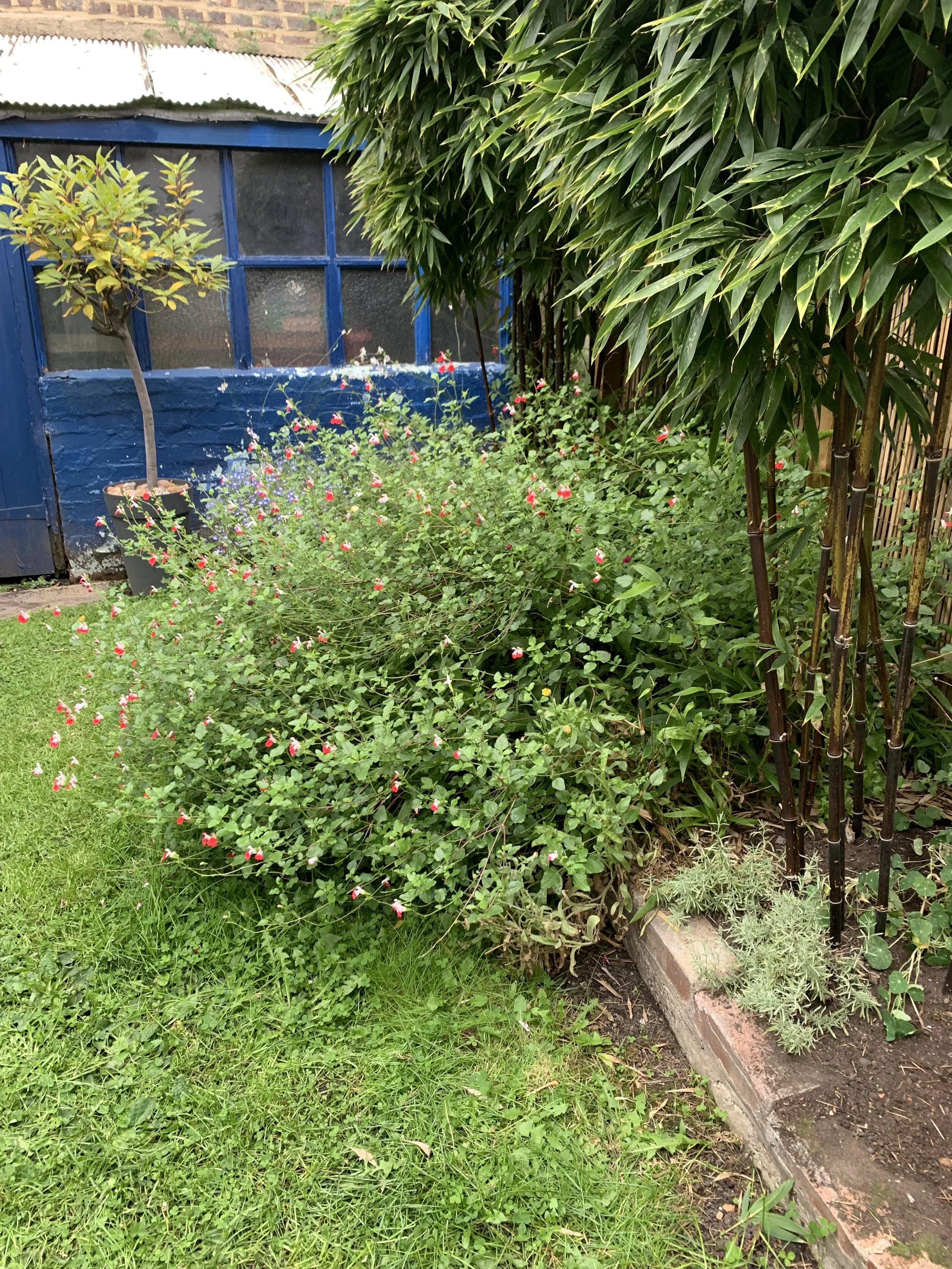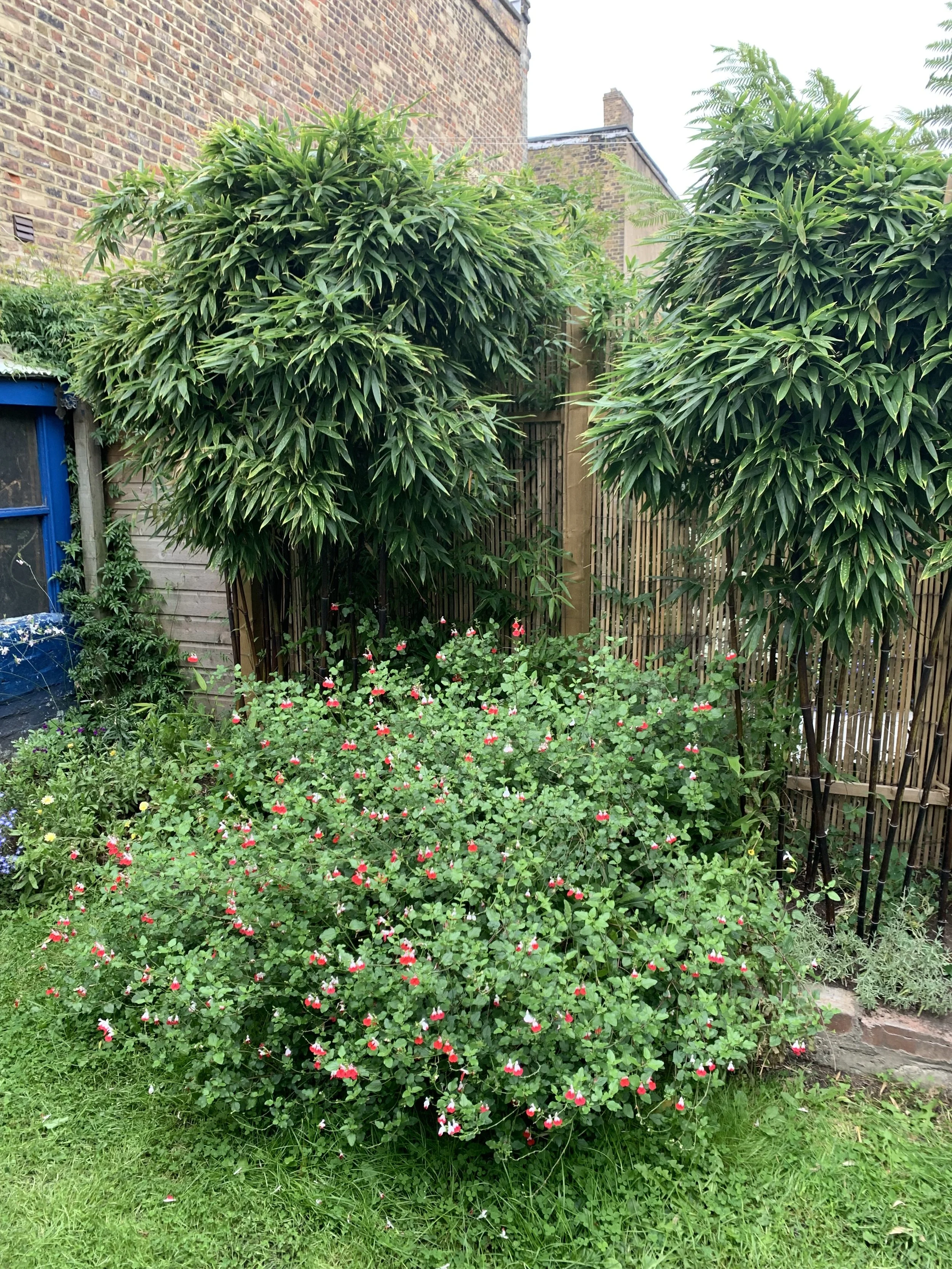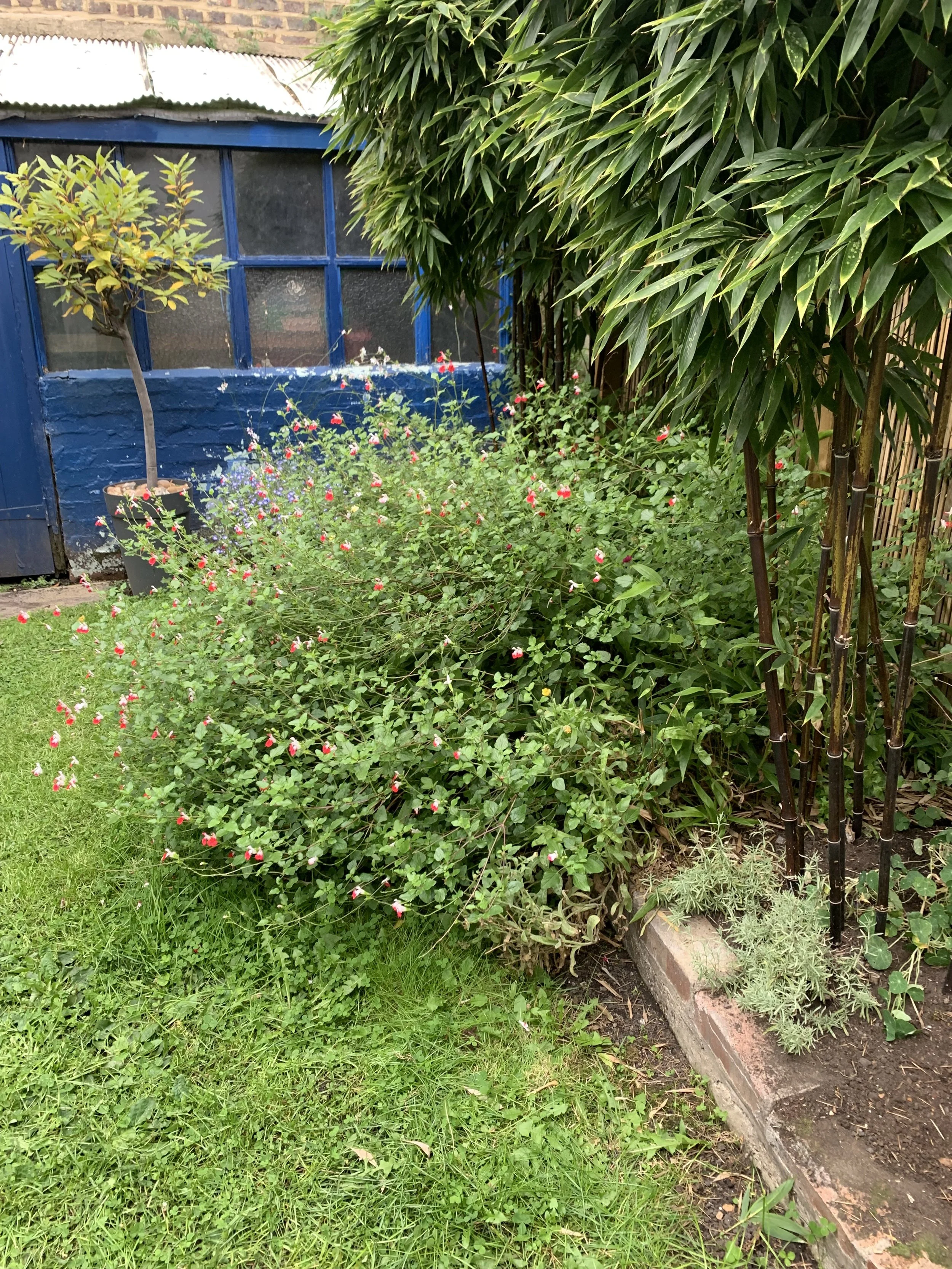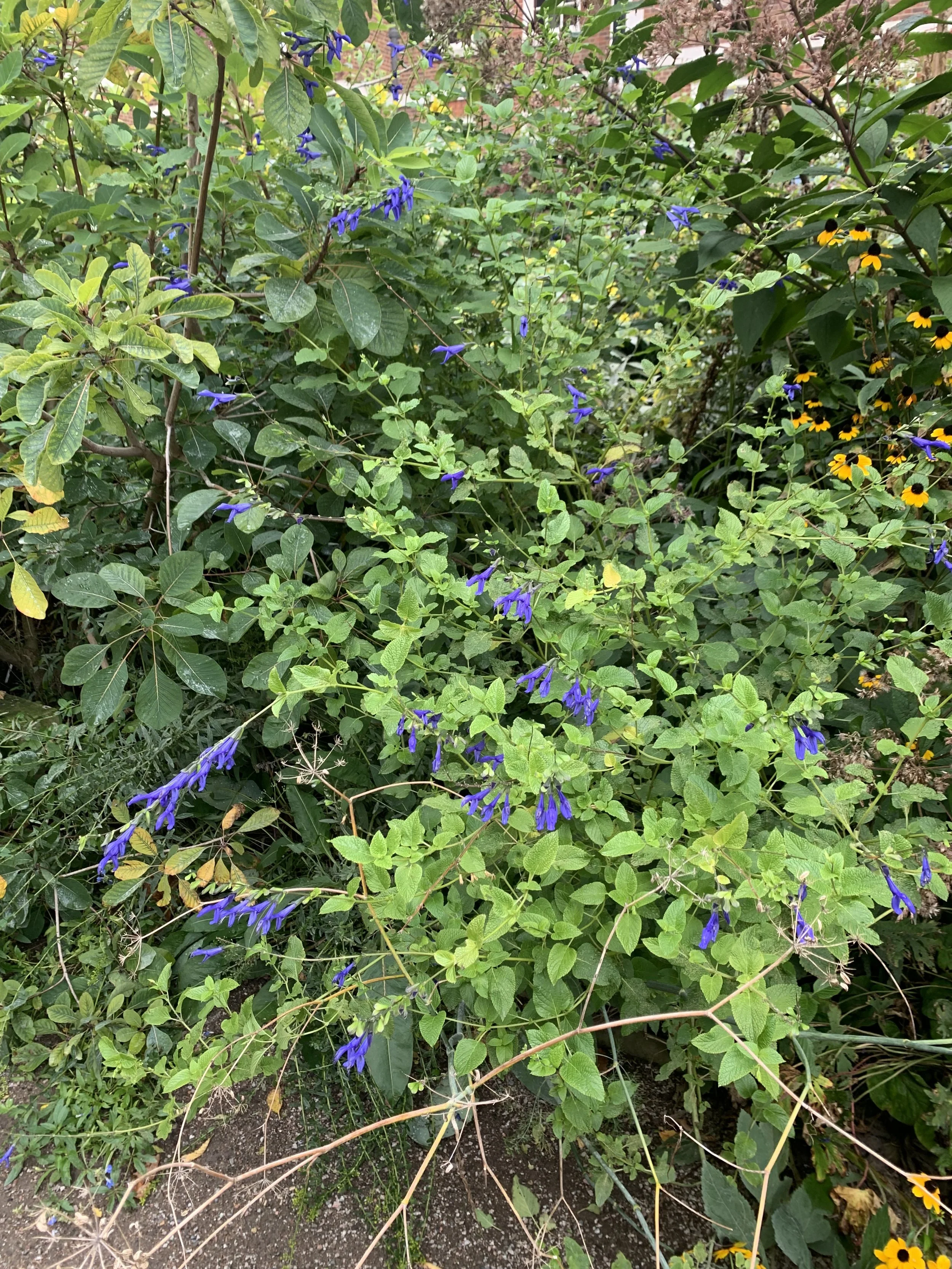Pruning Salvias: How to Prune for Abundant Flowers
This article has links to products that I may make commission from.
Salvias, known for their beautiful long-lasting blooms, are a really diverse group of plants that encompass both shrubby and herbaceous varieties.
Among the many types of salvias, deciduous herbaceous salvias require specific pruning techniques to ensure optimal growth and abundant flowers.
Here, we will explore the art of pruning salvias, focusing on different types, the benefits of pruning, and step-by-step instructions to guide you through the process.
To learn more about growing salvias, check out my guide:
My Salvia ‘Hot Lips’ in the backyard in desperate need of a prune.
How to Prune Salvias
Pruning salvias is a straightforward process that helps maintain the health, shape, and blooming performance of the plants.
Here is a step-by-step guide to help you prune salvias like a professional gardener:
Determine the appropriate time
A good rule of thumb is to prune salvias in late winter or early spring before new growth begins.
This allows the plants to recover and promote healthy growth during the growing season.
Prepare the tools
Get a pair of sharp, clean pruning shears or garden scissors.
Make sure they are sanitized to prevent the spread of diseases between plants.
These pruning shears are perfect for the job:
Assess the plant
Take a close look at your salvia plant and identify the areas that need pruning.
Look for dead, damaged, or diseased stems, as well as any overgrown or leggy growth.
Remove dead or damaged stems
Start by cutting off any dead or damaged stems at their base.
Make a clean cut just above a healthy bud or leaf node.
Removing these stems helps improve the overall appearance of the plant and prevents the spread of diseases.
Shape the plant
Determine the desired shape for your salvia.
Depending on the variety, salvias can have an upright, bushy, or sprawling growth habit.
To maintain a compact shape, trim back the outermost stems to encourage branching.
You can also lightly prune the tips of the stems to encourage bushier growth.
Manage leggy growth
If your salvias have become leggy or overly tall, you can prune them more severely to promote denser growth.
Cut back the stems by about one-third to one-half of their length, focusing on the longer, weaker stems.
This rejuvenation pruning encourages fresh growth from the base.
Deadhead spent flowers
Throughout the blooming season, it's beneficial to deadhead or remove spent flowers.
Pinch or cut off the faded flowers just above a pair of healthy leaves or buds.
Deadheading encourages the plant to produce more blooms and prevents the energy from being wasted on seed production.
Clean up
After pruning, gather and discard the pruned stems and plant debris.
Keeping the area tidy helps prevent the spread of pests and diseases.
Learn more about pruning and deadheading in order to encourage more flowers with my guides:
Deadheading Geraniums: A Guide to Encourage New Blooms
Deadheading Snapdragons: A Simple Guide to Promote Blooming
How to Deadhead Dahlias for Stunning Blooms
Pruning Winter Jasmine: Simple Guide
A great example of a Salvia ‘Hot Lips’ that needs to be pruned back in order to encourage more compact growth.
Check out my guide:
Do You Cut Salvias Back in Winter?
Yes, for many salvias, it is recommended to cut them back in winter.
However, the specific timing may depend on the type of salvia and your local climate.
Deciduous herbaceous salvias, such as Mexican bush sage, Salvia nemorosa, and Salvia greggii, are typically pruned in late winter or early spring, just before new growth begins to emerge.
This allows the plants to benefit from the dormant period during winter while preparing them for the upcoming growing season.
During winter pruning, it is essential to remove old, woody stems and any dead or damaged growth.
This helps stimulate new growth and promotes a healthier, more vigorous plant in the following year.
However, it's important to note that not all salvias require winter pruning.
Some varieties, particularly evergreen salvias, may require only light pruning or none at all.
Check out my guide: Growing Vibrant Salvia in Pots.
My Salvia greggii that has been pruned down to a more compact size.
Can I Prune Salvias in Summer?
While the ideal time to prune salvias is in late winter or early spring before new growth begins, there are situations where pruning salvias in summer may be necessary or beneficial.
Here are some scenarios where summer pruning might be appropriate:
Deadheading
Deadheading, which is the removal of spent flowers, can be done throughout the blooming season, including summer.
By regularly deadheading the faded flowers, you can encourage continuous blooming and prevent the plant from putting energy into seed production.
Shaping and maintenance
If your salvias have become unruly or overgrown during the summer, light pruning can help maintain their shape and promote bushier growth.
Trim back the longer stems by one-third to one-half of their length to encourage branching.
However, avoid drastic pruning during the summer, as it may disrupt the plant's growth and blooming potential.
Controlling size or spreading
Some salvias have a tendency to grow vigorously and may start encroaching on other plants or areas of the garden.
In such cases, you can prune back the more invasive or spreading stems during the summer to help control their size and prevent them from taking over.
It's important to note that pruning salvias during the summer may impact their blooming performance.
Late winter or early spring pruning allows the plants to focus on new growth and flower production during the growing season.
Summer pruning should be done selectively and with caution to avoid removing too much foliage and potentially compromising the plant's ability to photosynthesize and bloom.
Always assess the specific needs of your salvias, consider the variety, and be mindful of the local climate and growing conditions before deciding to prune during the summer.
Check out my guide:
Salva ‘Hot Lips’ growing way outside of my garden bed and ready to be pruned.
Hot Lips Salvias Pruning
Salvia 'Hot Lips' is a popular cultivar known for its stunning red and white bi-colored flowers.
Pruning 'Hot Lips' salvia follows the same general principles as pruning other salvias, but here are my specific tips for pruning Salvia 'Hot Lips'.
Remember to always use clean and sharp pruning tools to make precise cuts and minimize the risk of spreading diseases.
By following these guidelines, you can help keep your Salvia 'Hot Lips' healthy, well-shaped, and blooming profusely.
FYI: Here is where I recommend buying Salvia ‘Hot Lips’.
Timing
Prune 'Hot Lips' salvia in late winter or early spring before new growth starts to emerge.
This timing allows the plant to recover and produce new growth during the growing season.
Remove dead and damaged stems
Inspect the plant and remove any dead or damaged old stems at their base.
Make clean cuts just above healthy buds or leaf nodes.
Shaping the plant
'Hot Lips' salvia has a tendency to develop long, leggy stems.
To maintain a more compact and bushy shape, prune back the outermost stems.
Cut them back by about one-third of their length to encourage branching and denser growth.
These pruning shears are perfect for the job:
Encourage continuous blooming
Deadheading is particularly important for 'Hot Lips' salvia to promote continuous blooming.
As the flowers fade, pinch or cut off the spent blooms just above a pair of healthy leaves or buds.
This practice encourages the plant to produce more flowers throughout the season.
Monitor growth
'Hot Lips' salvia can sometimes grow aggressively, spreading beyond its intended boundaries.
If this is the case, you may need to prune more frequently to control its growth.
Trim back any unwanted or overgrown stems as necessary.
Fertilization
After pruning, consider fertilizing your 'Hot Lips' salvia to support its growth and blooming.
Use a balanced, slow-release fertilizer according to the manufacturer's instructions.
This is the balanced fertilizer I recommend using:
Equip your urban green space with my recommend top tier tools.
One of my favorite bright blue salvias at Inner Temple Garden that was pruned in early spring in order to have lush growth in the summer and fall.
Understanding Salvias and Their Pruning Needs
Salvias are a diverse group of flowering plants that belong to the genus Salvia, which is part of the larger mint family (Lamiaceae).
They are native to various regions around the world, including the Americas, Europe, Asia, and Africa.
Salvias are known for their attractive flowers, aromatic foliage, and in some cases, culinary or medicinal uses.
The genus Salvia encompasses a wide range of species, with over 900 identified so far.
These species vary in size, growth habit, flower color, and other characteristics.
Some salvias are herbaceous perennials, while others are shrubs or subshrubs.
Certain species are even considered annuals or biennials, completing their life cycle within a year or two.
Many salvias are highly attractive to pollinators, such as bees, butterflies, and hummingbirds, making them valuable additions to pollinator gardens.
Salvia is a good choice for a south facing garden because it is drought-tolerant, loves full sun exposure, and its vibrant flowers attract pollinators, making it a low-maintenance option.
Pruning plays a crucial role in maintaining the health and appearance of these plants, ensuring the production of vigorous new growth, increased flowering, and overall plant vitality.
Understanding their pruning needs can help you maintain their health, shape, and blooming performance.
Here are some general guidelines to consider:
Timing
In general, many salvias benefit from pruning in late winter or early spring before new growth begins.
This allows the plants to recover and promote healthy growth during the growing season.
Deadheading
Deadheading, the removal of spent flowers, is beneficial for most salvias.
Regularly remove faded flowers by pinching or cutting them just above a pair of healthy leaves or buds.
Deadheading encourages the plant to produce more blooms and prevents energy wastage on seed production.
Shaping and maintenance
Salvias may require shaping and maintenance pruning to keep them in desired forms.
To maintain a compact shape, trim back the outermost stems to encourage branching.
You can also lightly prune the tips of the stems to promote bushier growth.
If salvias become leggy or overgrown, you can prune them more severely to rejuvenate growth.
Focus on cutting back the longer, weaker stems to encourage fresh growth from the base.
These pruning shears are perfect for the job.
Pruning after flowering
For some salvias, especially those that bloom once, you can prune them back after the flowering period is over.
Cut back the spent flower stems to just above a healthy bud or leaf node.
This can help keep the plants tidy and prepare them for the next blooming cycle.
Species and cultivar variations
Keep in mind that different salvias may have unique pruning requirements due to their growth habits and blooming patterns.
Some salvias are woody perennials and benefit from selective pruning to remove old or dead wood.
Others may be herbaceous perennials or annuals that require more frequent pruning to maintain their shape and blooming performance.
Monitor growth and adjust
Regularly monitor the growth of your salvias throughout the growing season.
If they become overly leggy, floppy, or encroach on other plants, you may need to prune them more frequently to control their size and shape.
Remember to use clean and sharp pruning tools to make precise cuts and minimize the risk of spreading diseases.
By understanding the specific needs of your salvias and applying appropriate pruning techniques, you can help ensure their health, vitality, and abundant blooms.
For more inspiration, check out my guides:
Benefits of Pruning Salvias
Pruning salvias offers a multitude of benefits.
It helps remove old, woody stems and encourages the development of fresh, new shoots.
By removing old growth, the plant's energy is redirected towards producing more flowers and foliage.
Pruning also helps maintain the shape and size of the plant, preventing it from becoming overgrown or straggly.
Additionally, regular pruning enhances air circulation, reduces the risk of disease, and promotes a tidy appearance in the garden.
For more ideas, check out my guides:
Top 8 Salvia Picks
Are you ready to add some stunning salvias to your garden?
Here is my carefully curated list of the top 10 salvias.
Whether you're seeking bold and vibrant colors, compact growth habits, or beautiful fragrances, this list has something for everyone.
This list includes links to where I recommend buying each salvia.
Salvia officinalis (Common Sage):
A culinary herb known for its aromatic leaves, used in cooking and herbal remedies.
Here is the common sage I recommend:
Salvia splendens (Scarlet Sage):
An annual or tender perennial species known for its vibrant red flowers.
It is commonly used in summer bedding displays.
Salvia elegans (Pineapple Sage):
A tender perennial species with bright red flowers and aromatic foliage that smells like pineapple.
It attracts hummingbirds.
Salvia farinacea (Mealy Cup Sage):
A perennial species with spikes of tubular flowers in shades of blue, purple, or white.
It is often used in borders or containers.
Salvia greggii (Autumn Sage):
A woody perennial species with small, colorful flowers in shades of red, pink, purple, or white.
It is known for its long blooming season.
Salvia leucantha (Mexican Bush Sage):
A shrubby perennial species with long, fuzzy spikes of purple or white flowers.
It adds texture and color to garden borders.
Salvia coccinea (Scarlet Sage):
An annual or short-lived perennial species with red, tubular flowers that attract hummingbirds.
It blooms continuously throughout the season.
Salvia azurea (Blue Sage):
A tall perennial species with sky-blue flowers and gray-green foliage.
It is native to North America and attracts butterflies.
Whether you opt for perennial salvias that persist over winter, or shrubby salvias that bring structure and texture to your garden, these plants are sure to bring joy and inspiration.
As you embark on your gardening journey, remember to consider the specific needs of each salvia variety, including pruning, watering, and sunlight requirements.
With the right care and attention, your salvias will reward you with a beautiful display of colors, attracting pollinators and bringing life to your garden.












































